Back in February 2020, the world was a different place.
A general election had just been held and decisively won, Brexit was becoming a reality, and the Westminster government was poised to respond to both a major review of higher education funding and the framework it uses to judge teaching and student outcomes – with almost inevitable national knock-on impacts around the UK. “Generation Z” had become the mainstream generation on campus, and concerns about mental health and technology dominated the discourse.
To try to respond to that environment and help SUs with their strategy work, we published a PESTLE and curated a series of blogs under the tag #SUFutures to spark thinking and debate. We noted that lots of SUs and universities were in the middle of, or at least preparing to, refresh or renew their strategies to mark the turn of the decade. Several SUs had even described their “2020 visions” in previous documents – some of which had been realised, but many of which had inevitably fallen by the wayside.
But while all the issues that dominated the period are still around, February 2020 feels like a long time ago now for obvious reasons. The pandemic’s impacts have been huge, will have a long tail, and in many ways are hard to predict from here. Whichever part of the classic PESTLE analysis you think about, the potential for the fall out from the pandemic to last and have profound impacts on students, education, the economy, universities and SUs are vast.
So if you’re working at a students’ union that paused its strategy development work, or are somewhere where you’re due some kind of “strategic refresh” around about now, the big question is – is now the right time to do “strategy”? And if so, what on earth should that look like?
1. What are we strategically planning?
Strategy is all about deciding what to do, how to do it and when to do it. So we should start with an observation we made last January – most charities have things fairly easy from a strategy point of view given they have a defined purpose, a defined set of beneficiaries and relative clarity from funders about what is to be done with that funding. Of course needs change, beneficiaries evolve and funders’ prioritise morph over time – but the board is able to reconcile all of that and make a plan.
That all means that it’s understandable that the traditional strategic plan – both in universities and their SUs – tends to focus on organisations, and in students’ unions impacts on or changes to the “student experience” are often something where separate policy work or influencing actions are determined annually by officers and priorities. But the danger with that approach is that the SU looks more interested in itself than its members – because, in truth, sometimes it is.
Of course, actively and annually responding to democratic input from student leaders and structures is crucial in democratic environments. But SUs are principally associations of people. And some of the student movement’s responses to the long term challenges facing students – like housing, university funding, attainment gaps or mental health – have all arguably suffered from a lack of long term strategic thinking and planning.
The last massive economic shock to hit the country – and therefore education and young people – was 2007-8, when strategic planning in SUs was still pretty much in its infancy. And to the extent to which there are documents around from the time, they are impossibly and unforgivably thin on the challenges facing students rather than the SUs themselves. Given the scale of the economic shock now facing students and graduates, it would be surreal to make the same mistakes.
During the pandemic, under-25s are more likely to have been furloughed and to have struggled to find employment after losing their job due to the pandemic. Students’ mental health has taken a huge hit. Much of the education they were promised has been missing. Graduate jobs are in sharp decline, they’ve experienced untold upheaval over their education, and they have lived through lockdown in the smallest of “homes”.
These are not new issues – just extreme symptoms of a policy environment that is hostile to young people. For many years, they have been the most likely to experience insecure employment contracts and working in the gig economy. They get lower minimum wage guarantees and aren’t counted by the Treasury when it looks at the poorest households in society.
It’s also clear that over the past decade, student representation and policy work has become more complex and has seen investment (at all levels of staffing teams) from SUs. As we argued last year, the issues facing SUs’ members are too complex, “wicked” and long term to leave to manifestos and annual officer away days – they require external analysis, officer and staff collaboration, SU collaboration, external input, assertive institutional partnerships, distributed leadership and plenty of creativity in a sector that loves instead to copy and steal.
In other words, just as the SU as an organisation needs a plan, so do students. For every strand that rebuilds the SU’s reserves, there should be one that rebuilds the social connections and confidence of students locked up in the pandemic. For every “big SU survey” testing opinion on and engagement with the SU, there ought to be one that develops the SU’s understanding of students’ needs, lives and ambitions. And so on.
2. How should we factor in the pandemic?
Next, there’s an important question that surrounds the pandemic and its impacts. The daft thing would be to see the pandemic merely as some kind of “pause” – something to emerge from and get “back to normal” off the back of. Much of its impact will have been negative – but it may also have spurred on change, and ideas generated during it while under intense pressure may be things worth keeping.
Just take student activities and opportunities. There’s no doubt at all that the ability of students engage in wider activities – so crucial to their social and skills development, confidence and mental health – have taken a severe hit. But some of the things SUs have done during the pandemic must surely be things worth holding onto. The way in which SUs have facilitated web-based community activity has, for example, brought diverse students together in ways never previously thought of as possible.
Processes and forms and meetings we used to think vital have gone – many hoping, for good. And students – some on the other side of the world, some with access requirements that prevent physical participation – have been able to join in in ways never previously imagined. We’ll surely not throw all of that away?
Universities are having these conversations too – about homeworking, online teaching, meetings and decision making cultures and more. And let’s face it – while the debates over “no detriment” and “safety nets” were stressful – can we ever remember a time when students were so engaged in institution level conversations about their education? And can we remember a time when old fashioned democratic structures like councils looked anything other than irrelevant when judged against this more direct style of policy influencing and collective representation?
As Matthew Taylor from the Royal Society of the Arts argues, innovation and change arise from disruption to the dominant patterns and habits that comprised the status quo. That’s as true in SUs as it is anywhere. The more critical the shock, the more energy is released and the less able we are to ignore it – obvious faultlines are exposed but also, if we look and listen closely, we can notice what might be new foundations:
The faultlines revealed by the pandemic are diverse: inequality in all its often intersecting forms; the impact of austerity; conflicting moral perspectives between the primacy of the individual or the collective; the weaknesses of a globally-interconnected economic structures; and the opaque and nepotistic approach of the UK government to private sector partnership and procurement.
Foundations can be seen in new-found respect for our teachers and delivery drivers, in a greater solidarity with our neighbours, in car-free streets and rivers flowing clear. They can be seen – for a period at least – in accommodation being provided to those living on the streets, in less wanton consumerism and more mindful consumption and in more agile and collaborative public services as digital becomes the default. The bricks and mortar for new foundations were there before the crisis but urgency and shared purpose has started to bind them.
To help make sense of all of that, last year the RSA developed a raft of materials and other helpful work that can be discussed with your staff, officers, Trustee Boards and students under the banner of “Living Change”. The Future Change Framework was developed to help people and organisations capture and reflect on insights from the pandemic rather than just ignore them. This was not simply a process of some things being abandoned while others flourished, nor was there much spare time to think about whether crisis-driven adaption could or should be sustained. It was and is a way of capturing learning about the pandemic and possibilities in real time.
It identified four broad categories of response:

Some crisis responses are temporary measures, while others might prefigure new ways of doing things beyond the crisis. Some things we all halted were practices and processes that were already obsolete but too baked into our systems to easily change – now we have a legitimate opportunity to let them go. Other things are on pause, but we will likely restart them in a completely changed context.
Organisations have used it in all sorts of ways. A group of social entrepreneurs in the North West of England were deeply concerned about the impact of Covid-19 on vulnerable members of their communities – and they used the framework to trigger new thinking. As the founder of a charity dedicated to helping young people avoid a life of crime explained:
For most of our young people home is not home as we know it. Home to them is injurious and chaotic. We have extended support hours and also offer support to family members who have few parenting skills. Our service delivery is now remote, this has meant no working face-to-face, no mentoring in schools etc. Our sole focus has been to continue engagement and keep children and young people safe. We’ve realised that there was a lot we were doing that wasn’t necessarily economical in terms of time and money. Some aspects of business as usual are in place because that’s what we have always done”.
There’s a handy toolkit to go with the framework that you can adapt to use in your thinking with your board, your staff, your involved students and even in your thinking with the university. And if you’d like us to come in and help with any of that, do get in touch.
3. Turnaround and build back
As well as shifting the focus of strategy work and having a framework for handling the pandemic, there’s the big question of recovery. We’ve heard plenty of people argue – both inside and outside of education – that developing a “strategy” where you analyse the external environment, develop and choose from options and then execute them is the wrong process for the wrong time.
None of us know what sort of student body is coming, where the economy will be or where our universities will be at – and anyway, there’s too much to take in and respond to now. The argument is that the classic “long form” strategy is therefore utterly pointless now – because the right thing to do is to be ready to respond to a rapidly changing external environment, rather than assume it is stable and predictable.
They therefore argue that what’s needed now is a focus not on classic “long term, strategy”, but on rebuilding and recovery – a lot like a turnaround plan – with three distinct phases:
A: Short term/summer
What harms have been caused by the pandemic to us or our members? And what can we do to both recognise that and recover the position in time for September?
A focus here might involve surveying students on what they need to succeed in 2021/22, rebuilding depleted societies, re-establishing students’ confidence to get involved, rebuilding assertive trust with the university or giving exhausted staff some time off.
B: The year ahead
On a one year timeframe, the questions get bigger. What comes out of the “Living change” analysis, new officer manifestos and the emerging situation that the university is in – that we want to achieve and do by, say, September 2022?
A focus here might involve projects on access and participation in student activities, integrating rapid feedback and “closing the feedback loop” into student representation on courses. It might mean trying to get the reserves up to a sensible level, a new mental health or employability project that has students earn academic credit for taking part, or trialling a new way of developing policy over the issues that matter to students other than “motions”.
We’d also recommend getting involved in the UPP foundation’s Student Futures Commission next term.
C: The next three years
Then there’s the immediate post-pandemic period. This isn’t necessarily about grand visions for education – but it is about scenario planning to understand and serve the students that are coming. What kind of organisation do we want to be, and how will our actions in this recovery period help get us there?
A focus here might involve researching the social attitudes of those that are doing A levels or B Tecs. It might mean bold new ideas, rights, entitlements or service delivery ideas. You might abandon the rigid idea of a “clubs or society” in favour of more flexible forms of involvement. You might have an ambition that every student will do something other than their course by the time they leave. You might strive that the overall level of sexual misconduct or mental ill health is dramatically improved from a baseline you identify or measure.
Building back belief
Above all else, the immediate future – the part where we build back – has to involve a new kind of defence of students. Post-pandemic, many predict that the freedom that usually succeeds lockdowns may be fused with fresh and radical demands for fairness, of the sorts we’re starting to understand in relation to equality and diversity, and in other ways too. Students will be angry, and free – and SUs ought to be ready to harness that as energy rather than resist it as illegitimate.
Both the words and the deeds of the powerful over the pandemic have sent a message to students – that they don’t matter, are not valuable, not worthy of help or assistance, and are either “snowflakes” or enemies of freedom (of speech). So student organisations have a powerful duty in the coming years – to not only work to improve the image and reputation of themselves as organisations in the face of attacks, but to do the same for their members – not just internally, but externally too.
We have to send a clear signal both to and about our Gen Z members – that job or no job, they are valuable to the country, communities and society, and have a part to play in and agency over the story of what comes next. Previous generations need to respect them – as those that will shape a better future for the country rather than constantly decrying them as those that will wreck it.
It means that as well as clubs and societies and course rep systems and cafe bars, both intergenerational fairness and intergenerational trust become crucial tasks for associations of students – with a focus on talents not grades, possibility and creativity, and the kind of radicalism that we need to solve issues like the climate crisis, deepening inequality and the viciousness of populist politics.
We need, in other words, to believe in students, and for them to believe that we do. That’s the KPI.


















